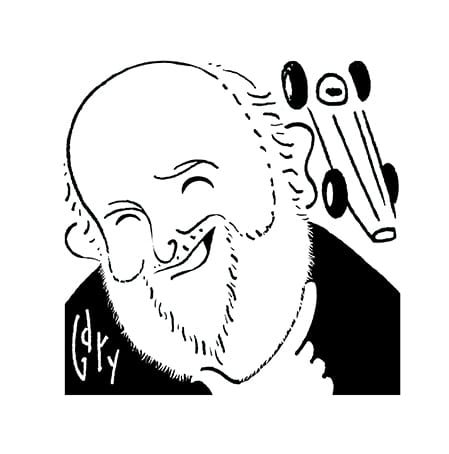Doug Nye: When the wheels fall off
“Back in the 1960s, the challenge was to make a tyre to last an entire race”
 Over long decades major manufacturers and their sponsors have invested colossal sums of money and expertise in what used to be called Grand Prix racing.
Over long decades major manufacturers and their sponsors have invested colossal sums of money and expertise in what used to be called Grand Prix racing.
Lucrative payback has come from the mushrooming media audience captured. But while positive brand promotion has been claimed by most, just occasionally, and in some cases literally, the wheels have come flying off… Instead of selling more production cars, beverages, cigarettes, computer software, or tyres, the F1 spectacle could instead persuade many consumers to buy any brand other than the one they have just seen spectacularly fail.
An old German friend of mine – who sees motor racing as “…a boring zum-zum-zum silly little cars, bunch of guys chasing one another round in circles for 90-minutes…” – also offers this insightful comment: “Listening to the TV commentary; all about tyres doing this, and tyres needing that. To care about that stuff you gotta be some kind of rubber fetishist…!”.
Well, after what was – perhaps arguably – a sleep-inducing 95 per cent of the British GP, the final three laps provided just about the most tense drama and excitement that any (F1) rubber fetishist could ever want.
First Valtteri Bottas’s second-placed Mercedes had its left-front tyre disintegrate, then Carlos Sainz Jr’s McLaren suffered a matching failure, followed by Lewis Hamilton’s leading Mercedes. The pulsating tension as he nursed that stricken three-wheeler to the chequered flag just five seconds ahead of the charging Max Verstappen’s freshly re-shod Red Bull is now written into the record books.
What struck me was the manner in which, after Hamilton had brought his car to rest post-race, and inspected the tattered ruins of that left-front tyre, an official or a team or tyre supplier factotum – apparently deliberately – blocked the view of the prying TV camera, shielding ripped rubberware from a lengthy close up. The evidence was then shrouded in a handy rose-coloured bag – ‘protecting’ the corpse’s scuffed, part-molten Pirelli branding.
Yet this was a tyre which had been worked beyond the end of its apparently natural life, to carry the winning car to its driver’s record- breaking seventh victory in his home Grand Prix. Not too shabby in performance terms – but fallibility absolutely does not jive with current corporate sensitivity.
Back in the 1960s – and for much of the ’70s – the problem with racing tyres was not so much to make them survive a lengthy stint at race-winning pace, but – in F1 – to survive an entire race, start to finish. Through 1961-63 lightweight, relatively low-powered 11⁄2-litre F1 cars ran exclusively on Dunlops, really designed to carry a 2000lb 300-horsepower sports car for as much of the Le Mans 24 Hours as possible. Such overkill famously enabled Team Lotus and Jim Clark to run the self-same set of well-scrubbed ‘concrete’ tyres for more than one Grand Prix. But in 1964-65 Dunlop had to pay real attention, because the American Goodyear and Firestone brands were invading the road racing world, and tailoring tyres specifically to different demands.
“Ferrari convinced the court the tyre had been slit by cat’s-eye markers”
In 1965 Goodyear both shod the Le Mans winner and notched its first World Championship F1 win – on Richie Ginther’s Honda in the Mexican GP. By 1966 Firestone was into F1, taking two GP wins on the John Surtees and Ludovico Scarfiotti Ferraris. In 1981 four suppliers clashed in F1 – Michelin, Goodyear, Avon and Pirelli. Bridgestone did battle with Goodyear in 1997 and became sole supplier 1999-2000 before Michelin re-entered the fray 2001-2006. From 2011 Pirelli has held the monopoly, and has experienced – it has to be said – a sometimes rocky ride….
But of course the most disastrous weekend thus far by any F1 tyre supplier was Michelin’s experience at the 2005 Indianapolis GP. Standing-wave deformation of not just one, but two different tyre types’ sidewalls at high speed around banked Turn 13 either split the carcass and caused an explosive deflation, or threatened to do so. Such inadequacy, and the organisers’ inability to agree any circuit change that might have side-stepped it, led to the race featuring only six Bridgestone-shod cars – and the embarrassingly unembarrassed Michael Schumacher heading a Ferrari 1-2.
Back in 1957 Ferrari suffered a tyre shortcoming when the Marquis de Portago, his navigator Ed Nelson, and nine luckless spectators died in the disaster which ended the classical Mille Miglia. De Portago’s big 4.1-litre Ferrari 335S burst its left-front Englebert and went into the roadside crowd. Pirelli had wanted Ferrari to pay for tyres while old man Englebert – whose tyres had been used by the Scuderia Ferrari pre-war – was offering attractive terms. Englebert tyre technology was old, however, and once it became apparent that de Portago’s accident had been triggered by a tyre burst, both Englebert and Ferrari faced manslaughter charges. In their defence, they convinced the court that the tyre had first been slit by de Portago drifting across cat’s- eye markers recently installed near Goito village, four flat-out miles before the accident site. The court cleared Ferrari and Englebert, but cat’s-eye markers would not be widely reintroduced in Italy for decades. In contrast – at Silverstone – while Pirelli might have taken a public knock, hey, a win’s still a win…
